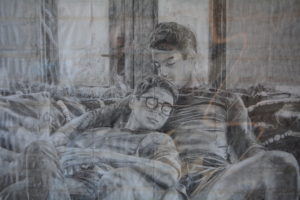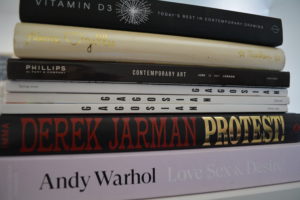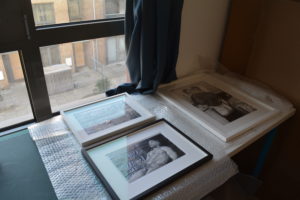By Zoë Goetzmann
Artist Spotlight – Interview with James Robert Morrison
This week on Cosimo Studio Tours, we head down to James Robert Morrison’s studio in southeast London. Born in Elgin, Scotland, James is an artist whose artwork stems from personal experience.
The artist aims to reflect on the pivotal experience of discovering an individual’s sexuality and the journey that they must take when it comes to understanding, accepting, and valuing it.
His pencil and cigarette paper, or ‘Fag Series’, entitled ‘There’s Never More Than a Fag Paper Between Them’, engages directly with the subject matter through which he depicts and captures LGBTQ plus couples and intimate yet tender moments.
In this interview, we speak all about his process, his delicate drawn creations, representation, queer artistic perspective, working in the commercial gallery and government art sectors, as well as how emerging artists can build and shape their professional careers.
You can listen to the full interview on our podcast here.

Zoë: Thank you, James, for being here and taking the time to speak with me.
James: Yeah, thanks. No problem. It’s nice to have you.
Zoë: I’m so excited because we’ve known each other through art world events, and I really admire your work. I got to see your previous work, so I’m excited to speak about where you are now.
So, to delve in, I like to start each interview by asking about an artist’s story. Essentially, how did you get into this career? How did you choose to become an artist?
James: So both my sister and I are kind of the creative people in our family. She’s two years older than me, and we’re also very close. I think growing up, she kind of encouraged me to be creative.
Then in primary school, an art teacher must have said to me, “You know, you’re good at drawing or something.” When someone tells you that you’re good at something that you actually like doing, it kind of makes it even better.
So then in secondary school, I studied art. I chose to do Scotland standard grade, which is like GCSE, and I also did higher, which is like A-level, which I really enjoyed.
They were also really encouraging. I knew I wanted to go to university, and I knew it was art school I wanted to go to, but I don’t think I ever said out loud to anyone that I wanted to be an artist.
I probably said graphic designer because there were more job opportunities and my mom would have been less concerned about me being a graphic designer than an artist.
Then I went off to study straight from high school and did my degree in Fine Art at Gray’s School of Art in Aberdeen. In Scotland, it’s slightly different than London.
So your first year, you do kind of everything: painting, sculpture, printmaking, graphic design, textiles, and product design.
Then at the end of the first year, you specialize in something for the next three years. For me, I’d always wanted to do painting. The painting course is the most popular, and you might not get it, but luckily, I got it. I did painting for three years.
When I finished, I knew I wanted to do an MA in London at one of the big schools. So I had a difficult final year; I couldn’t really make what I wanted to make in my head. Even on the last day of the final show, I was still making a painting, which ended up being the most popular one. I got the 2:1 I needed to do the MA, and in the summer, I basically phoned around to ask if anyone had spaces.
Central Saint Martins did, so I went there, did my MA for a year, had a great time. When that finished and I graduated, I just came back to the studio.
I don’t come from a wealthy family that could help me or support me to be an artist. Within a month of completing my MA, I was basically signing on the dole here because I had no money. Then I just had to find a job basically.
For the next 17 years, I worked in the museums and galleries sector. It was only in 2019 that I was in a position where I could go part-time and go back into the studio and start my practice again. It’s been a long and difficult journey.
I would have loved to have been an artist straight out, but it just wasn’t possible for me then.
I had to pay debts and I couldn’t find a way to do it, really. And maybe I was too young anyway.
And you know, I just wanted to have fun really, I don’t think I would have taken it so seriously. But you know, but 44 this year and I think coming back to this in later life, I take it much more seriously and try harder.

£250.00
Zoë: Okay, can you talk about your artistic practice? It can be how it’s changed or progressed… Maybe your influences?
James: I’ll maybe go broad because there are two key elements in my work.
The first is personal experiences and subject matter, and the second is the referencing and reappropriation of a personal archive of gay pornography that I collected during my teenage years. I knew I was gay at the time (13-14 years old), but I didn’t come out until 2021.
Back then, things weren’t as acceptable, and there was little representation of being gay in mainstream media. Most of it was negative, like the AIDS pandemic.
These magazines were the only place I could see representations of intimacy between two men, which I craved to see. I started making work about my sexuality in my final year of university, but I didn’t have much to say other than “I am gay.”
Going back to it 17 years later, I want to normalize non-heteronormative identities and make work that has a nostalgic narrative to it. I’m working with material from my teenage years, and I want to fill that void of positive queer representation that I and many others didn’t have in our formative years. I do this through three series: “Never More Than a Cigarette Paper Between Them,” which is drawings of male gay couples being intimate in domestic settings, taken from and referenced from pornography. It has been ongoing for a while now.
I also do a series called “Ghosts Within Me,” which uses pages from pornography magazines. I discovered that I could erase the image of the model with a Mars eraser and embroider the figure from the other side.
It’s playing on the idea of what a person conceals or reveals, and the images look like ghosts. This series is about how I concealed my true sexuality growing up, and my true self was like a ghost living within me.
The third series is paintings that haven’t been exhibited yet, which marries imagery from paper clothes patterns and porn magazines. I’m deconstructing my past decision to protect and cover myself by not being open about my sexuality.
Embroidery plays a significant role in my work, like masturbation or sex. It’s repetitive, emotional, and physically enduring. You’re going in and out of the canvas or linen. Embroidery also has a link to clothes because you can stitch clothes.

Zoë: Okay, well, I’m going to the next question. So, if you could tell me, what is the least favorite part of being an artist or of the art world, and you can try to be as careful as you can or not.
James: I struggle with art speak. When I was studying and we had contextual studies and things in theory and stuff that I was like way out of my depth, and I had no idea what it meant. I really struggled.
You know, I went to art school thinking, I’m just going to be doing art, not writing and dissertations are quite difficult.
I also find it quite hard to write about my work. It’s taken me a long time to get my artist statement where I wanted it to be, but I persevered and got there, but it took a long time.
So yeah, I find exhibition descriptions and even artwork descriptions sometimes are written in such a way that it’s just above my head, and it must be above many other people’s heads. And I don’t know why they do that. It’s kind of strange.
They like to make it sound more intellectual than it is, or I think. If I’m going to see a show, if I can find a curator talk or an artist talk about the show, I will go to that.
Because I always get so much more from that if it’s the artist or the curator talking about the work to me, rather than reading it on a panel. And it’s just, I think people speak differently than how they write sometimes.
I’ve been told that before that, you know, if you didn’t find an application, speak it out yourself and write it down. Because I’ve been told sometimes that when I speak about something, it’s much more exciting than when I write about it.
So, I think yeah, just it puts people off a bit and yeah, people that are already afraid of contemporary art because they don’t understand it. And then if you try and read a label to understand it, and it’s not written in a language that you kind of understand.

Zoë: Okay, but maybe going into that what advice – artist-to-artist – what advice would you give to up-and-coming artists?
James: Yeah. I think the main thing is, I don’t think there are many artists out there who make a living just from their artwork, so you’re probably going to have to have a part-time job.
If it’s related to the art world, it might help with pay, as well as definitely help. So you’re probably going to be splitting two, which is good, but difficult as well.
I have found that difficult for the past few years because, you know, that’s not my studio days. Monday, Tuesday, I’ve been in the studio that weekend as well. And, you know, by Tuesday, I’m getting really into what I’m doing, and then I have to stop and then I have to become Government Art Collection James and then do that Wednesday, Thursday, Friday, then I got really into that, and then I have to stop that and then have to go back to the Norris gym.
So it feels a bit like you’re kind of leading two different lives, and you try not to let them overlap. But sometimes it does.
You know, sometimes I have to swap days if there’s something big happening at the art collection. I might have to go in on a Monday or Tuesday to be part of it. And other times, sometimes I have to deliver stuff from exhibitions or pick stuff up on a Friday or a Wednesday or Thursday, and then I have to try and swap stuff around.
So yeah, that’s quite difficult. But then you get used to it as well.

Zoë: How do you balance between these two lives? And do you have any other advice for artists?
James: I think it depends on what you want. You know, I mean, what do you want? Do you want this to be your main career? Are you just making some work and selling it on the side or so it really depends on what you want.
But you have to work hard you know, you get back what you put in. I think even with materials, and it’s not always easy, but always buy the best materials you can afford.
And if you work on paper, always get the best frames you could afford. And get them done by a proper framer, don’t just go to IKEA and buy an Ikea frame. Get your work professionally photographed.
If you can’t do it yourself, find someone, ask around your studio, there’s usually someone that does. I think you have to present it the best way possible and use the the best kind of materials you can I think you have to be confident in your work as well.
Because if you’re not that confident in what you’re doing, I think it’s a big ask to ask other people to be confident in what you’re doing. And talk to other artists. You know, I’ve always been a bit afraid to do that.
But over this past kind of year or so, I’ve put myself out there and just asked people something I want to ask them, and I’ve never had a negative reaction, or been ignored, you know, so I think other artists are supportive of each other as just maybe how you approach in covering understanding, you know, someone might be busy doing work and make them work for a new show or something, but they’ll probably tell you that anyway.
And they might find a time to speak to them. But you can always ask people, you know, if someone asks me anything, I’ll try and help if I can. You know, we’re all in the same boat, and we should kind of be supportive of each other.
I think if you want don’t sit in your studio waiting to kind of be discovered because it’s not going to happen.
Go and see shows that other artists are making, it’s good to see what other people are doing. Network.
You know, this is if you’re like me, I’m quite awkward, that kind of thing. And I don’t like to. But, you know, a lot of the time that seems to be who you know, and not what you know.
So it is probably worthwhile getting out there and talking to people and getting to know people and you know, trying to find common ground, but it’s time as well.
You know, sometimes you don’t have time to go out to these things. But apparently, it helps. And, and this is a good one, which like I never really thought of this like but it’s a marathon, it’s not a sprint, you know, most artists are in it for the long term.
Zoë: I think I think those are perfect. Thank you so much, James for taking the time, it’s been such an in-depth discussion.













